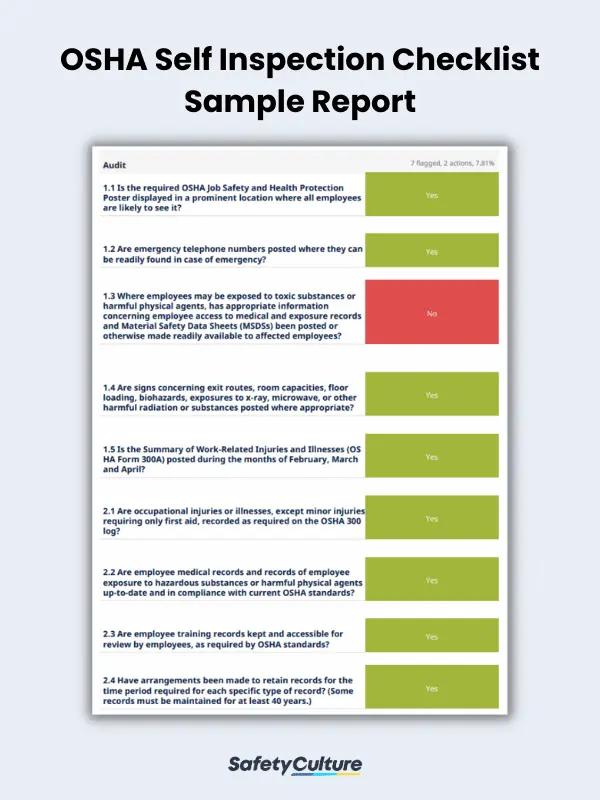What is an Inspection Checklist?
An inspection checklist (also referred to as an inspection sheet) is an essential tool for inspectors and professionals across multiple industries. Inspection checklists help assess the compliance of a process, procedure, equipment, or facility with industry, governmental, or internal standards. Using an inspection checklist ensures that the object of inspection goes through a detailed and documented evaluation. Once the inspection has been completed with the help of a checklist, the object of inspection can then be endorsed for its intended use. Aside from compliance, inspection checklists are also used to validate the safety, quality, and/or efficiency of business operations.
Purpose
Inspection checklists are used by professional inspectors primarily as a guide for performing appropriate assessments to determine if what is being inspected—whether that is a product, equipment, facility, or service—meets a certain quality or is performing according to customer expectations or specifications set by regulations or industry standards. When used correctly, inspection checklists help with the following:
- Keeping people organized and focused on the task at hand
- Promoting accountability as inspection results serve as written records
- Boosting employee morale, knowing that facilities and equipment are inspected for compliance with regulations and industry standards
- Providing clear documentation to regulatory bodies about the inspections performed
Importance
Inspection checklists are important because they are vital to keeping a product, equipment, facility, or property compliant with existing safety regulations and up to par with industry quality standards. For industries that deal with tasks related to manufacturing, construction, automotive, facility management, and food safety and production, checks guided with the use of inspection checklists help businesses from different industries ensure that the products and services their customers receive will meet or exceed expectations. Further, regular inspections conducted using inspection checklists provide more benefits to organizations in the form of the following:
Safety
Regular inspections help define the line between a safe working environment and one beset with hazards.
Maintenance
Equipment and facility abuse is discouraged by regular inspections. With inspection records, maintenance managers can strengthen maintenance programs as inspections help them identify the best frequency of schedules for the upkeep of assets.
Reputation
No company is looking forward to appearing on the news when something wrong happens. Through regular inspections, companies are able to immediately rectify issues before they become major.
Business Costs
Periodic inspections help prevent workplace injuries, which can result in costly lost work time and compensation claims.
What to Include in Your Inspection Checklist
The content of your inspection checklist will depend on its purpose. The questions or items stated in the checklist are tailor-fitted to the focus of the inspection and influenced by the standards and requirements administered by either the organization or governing bodies.
Here is a sample inspection checklist for reference.
Although this focuses on self-inspection, its contents are used for many other purposes. Here are a few question examples you can include in your inspection checklist:
General Information
No matter the kind of inspection checklist you create, it is important that you include all the basic information that everyone can circle back to when needed. Some important information include:
- What is the name of the inspector?
- What is the date of the inspection?
- Where is the location of the inspection?
- What’s the name of the company to be inspected?
- What is the name of the /team/project/business unit to be inspected?
General Work Environment
Most inspection checklists contain safety-related items to ensure a safe working environment for employees and for the place of business. Some work environment questions can be along the lines of:
- Are all worksites sanitary, orderly, and free of clutter?
- Are work surfaces kept dry and slip-resistant?
- Is combustible waste removed from the worksite properly and stored safely?
- Are all work areas adequately illuminated?
- Are all confined spaces compliant with 29 CFR 1910.146 (permit for confined spaces)?
Machineries and Equipment
Workplaces have their own set of machines and equipment used on a daily basis. To ensure their safe operation, consider asking the questions below:
- Are the employees properly trained on safe methods of machine/equipment operation?
- Is there a regular inspection of machinery and equipment?
- Are all machinery and equipment properly maintained?
- Are all emergency stop buttons easily identifiable?
- Are machine guards secure and accessible?
FAQs about Inspection Checklists & Forms
Inspection checklists and forms have many types, such as the following:
- General workplace inspection checklists
- Equipment usage inspection checklists
- To-do checklists
- Troubleshooting inspection checklists
- Safety inspection checklists
Some of the most common examples and uses for inspection checklists and forms include the following:
Yes, there are many mobile platforms available now for creating, managing, and using inspection checklists and forms. However, no one inspection checklist app is like the other. Each checklist app will be different and will cater to different needs.
Regardless, it would be best to use a multi-functional checklist app that is suited for all and any industries to have flexibility in your workflow. Choose a mobile app that will also work on computers, be usable offline, and give you the option to upload media files as needed.




